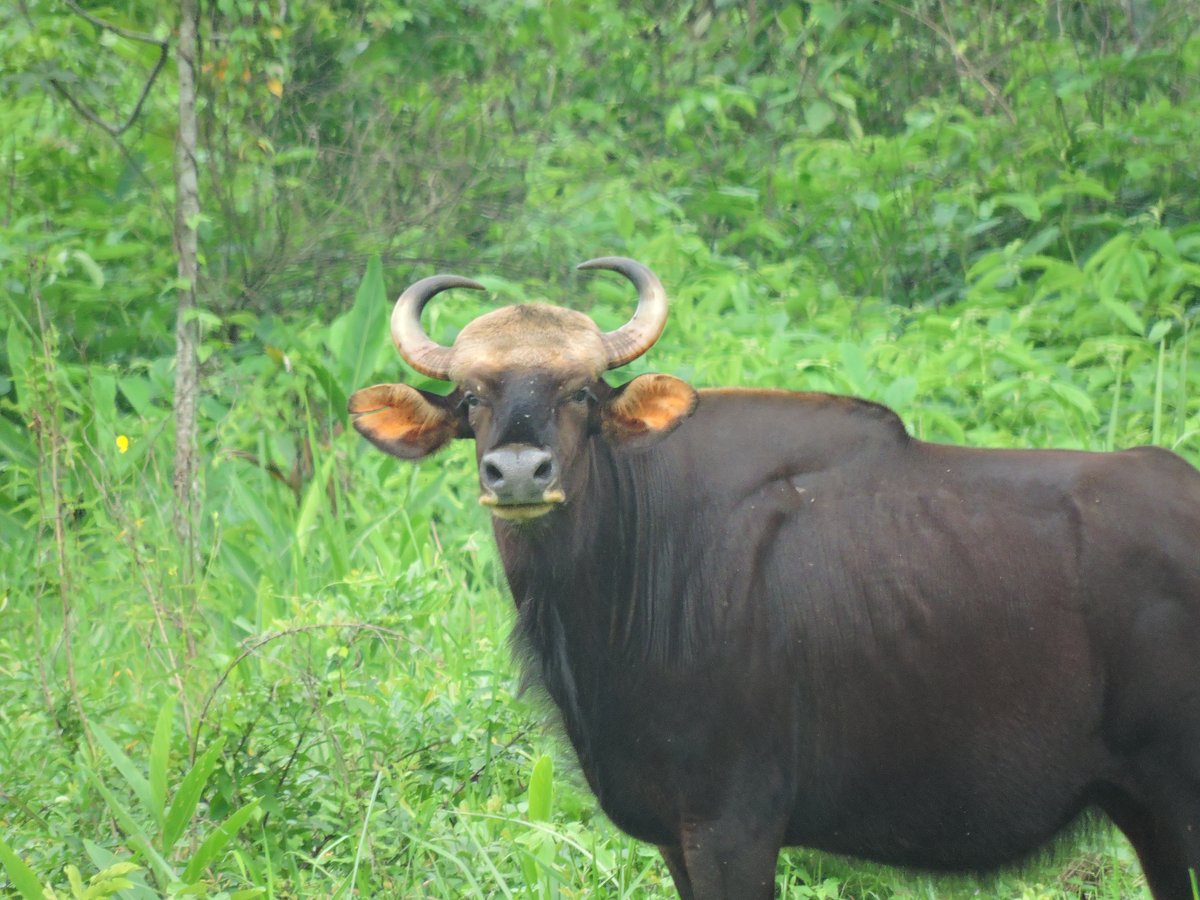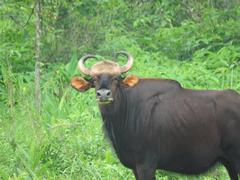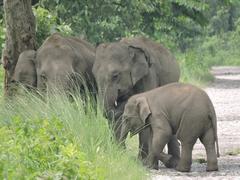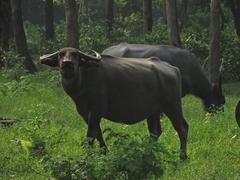
Manas National Park Visiting Hours, Tickets, and Travel Guide
Date: 14/06/2025
Introduction to Manas National Park
Nestled in the lush foothills of the Eastern Himalayas in Assam, India, Manas National Park is a world-renowned protected area recognized for its remarkable biodiversity, conservation achievements, and vibrant indigenous cultures. With multiple designations—including UNESCO World Heritage Site, Tiger Reserve, Elephant Reserve, Biosphere Reserve, and Important Bird Area—Manas stands as a symbol of both ecological and cultural significance (assamupdate.com). The park is not only a haven for rare and endangered wildlife such as the Bengal tiger and Indian rhinoceros but also a living landscape shaped by the traditions and stewardship of the Bodo people.
This comprehensive guide provides up-to-date information on visiting hours, ticketing, safari options, travel logistics, cultural experiences, and responsible tourism practices to help you make the most of your journey to Manas National Park (manasnationalparkonline.in; holidify.com).
Table of Contents
- Introduction
- Early History and Establishment
- Expansion and International Recognition
- Conservation Challenges and Recovery
- Visiting Manas National Park: Hours, Tickets, and Permits
- Getting There: Accessibility and Travel Tips
- Wildlife and Birdwatching Highlights
- Safari Options and Activities
- Nearby Attractions and Cultural Experiences
- Community and Cultural Heritage: The Bodo People
- Responsible Tourism and Conservation
- Frequently Asked Questions (FAQ)
- Conclusion
- References and Useful Links
Early History and Establishment
The roots of Manas National Park trace back to 1907 when it was designated a reserved forest. Officially declared a sanctuary in 1928, the park was named after the Manas River, a major Brahmaputra tributary steeped in local mythology and ecological importance (naparks.com; diversityassam.com). The area initially covered 360 square kilometers and has since grown to encompass approximately 950 square kilometers, extending into a vital transboundary conservation corridor with Bhutan’s Royal Manas National Park (nationalparksassociation.org).
Expansion and International Recognition
Over the decades, Manas emerged as one of India’s most significant conservation areas. In 1985, it was inscribed as a UNESCO World Heritage Site, and it remains the only Indian site to simultaneously hold five prestigious designations (assamupdate.com). This international recognition underscores its global ecological importance and the success of ongoing conservation and community engagement initiatives.
Conservation Challenges and Recovery
Manas faced severe challenges during the late 20th century, particularly due to political unrest associated with the Bodo movement. This period of turmoil resulted in habitat loss, increased poaching, and a drastic decline in populations of flagship species such as the Indian rhinoceros and Bengal tiger (wti.org.in). Placed on the UNESCO World Heritage in Danger list in 1992, Manas has since made a dramatic recovery. The formation of the Bodoland Territorial Council in 2003, coupled with strong community involvement and international conservation projects, has led to successful species reintroductions and ecosystem restoration (manasnationalparkonline.in).
Visiting Manas National Park: Hours, Tickets, and Permits
Visiting Hours
- November to April: The park is open daily from 6:00 AM to 5:00 PM.
- May to October: The park is generally closed due to the monsoon season and related safety concerns.
Ticket Information
- Indian Nationals: Entry fees range from ₹50–₹200 per adult, depending on the zone and activities.
- Foreign Nationals: Entry fees are typically ₹500 per adult.
- Additional Charges: Apply for vehicles, safaris, guides, and camera usage (₹100–₹300).
- Safari Permits: Required for jeep and elephant safaris; book in advance through the official website or authorized operators.
Booking Tips
- Peak Season: November–April; book tickets and safaris early.
- Online Booking: Strongly recommended to avoid queues and ensure availability.
Getting There: Accessibility and Travel Tips
- By Air: The nearest airport is Guwahati’s Lokpriya Gopinath Bordoloi International Airport (176 km).
- By Rail: Barpeta Road Railway Station (22–40 km from park entrance).
- By Road: Well-connected by bus and taxi from Guwahati, Barpeta Road, and other Assam towns.
Travel Tips:
- Carry valid ID and confirmation of bookings.
- Use authorized guides and safari operators.
- Pack binoculars, neutral clothing, a hat, sunscreen, and insect repellent.
- Accessibility for visitors with mobility challenges is limited; contact park authorities for assistance.
Wildlife and Birdwatching Highlights
Manas National Park is famous for:
- Mammals: Bengal tiger, Indian rhinoceros, wild water buffalo, Asian elephant, golden langur, pygmy hog, hispid hare.
- Birds: Over 450 species, including Bengal florican, great hornbill, and a variety of migratory birds.
- Habitats: Expansive grasslands, riverine forests, and tropical moist forests.
Photographers and birdwatchers will find the best opportunities during early morning and late afternoon safaris, especially along the Manas and Beki rivers.
Safari Options and Activities
- Jeep Safaris: Early morning and afternoon sessions; best for spotting large mammals and birds.
- Elephant Safaris: Unique perspective of the park’s grasslands (limited availability).
- Guided Nature Walks: Available in buffer zones for birdwatching and plant identification.
- Cultural Tours: Visit Bodo villages for traditional music, dance, and craft demonstrations.
Nearby Attractions and Cultural Experiences
- Mathanguri: Scenic forest lodge on the Manas River; panoramic views and wildlife observation.
- Bansbari Tea Plantation: Explore Assam’s tea culture near the park entrance.
- Bornadi Wildlife Sanctuary & Bogamati: Additional wildlife and scenic spots within driving distance.
- Cultural Sites: Kamakhya Temple in Guwahati, ancient temples in Tezpur, and local eco-tourism festivals.
Community and Cultural Heritage: The Bodo People
Indigenous Stewardship
The Bodo community, principal custodians of the Manas landscape, has a deep-rooted connection with this land. Their agricultural practices, artisan skills (notably weaving), and vibrant traditions are integral to the region’s identity (manasnationalparkonline.in).
Festivals and Traditions
- Bwisagu (Bodo New Year): Celebrated with music, dance, and communal feasting.
- Domashi and Dwijing: Highlight the agrarian cycle and showcase Bodo heritage (manasnationalparkonline.in).
- Other Festivals: Rongker, Wangala, Magh Bihu, and Durga Puja.
Community-Based Tourism
- Homestays and Eco-Lodges: Experience local hospitality, cuisine, and participate in cultural programs.
- Women’s Role: Bodo women are central to cultural preservation through weaving, music, and oral traditions.
- Conservation Engagement: Initiatives like the Manas Maozigendri Ecotourism Society involve locals in wildlife patrols, anti-poaching efforts, and visitor education.
Responsible Tourism and Conservation
Visitors are urged to:
- Stay on marked trails and follow all park regulations.
- Avoid disturbing wildlife or using plastic.
- Support local communities by choosing community-run accommodations and purchasing local crafts.
- Engage respectfully with local traditions and seek permission before photographing people or sacred sites.
Community involvement has been key to Manas’ conservation successes, including the recovery of flagship species and sustainable tourism development (wti.org.in).
Frequently Asked Questions (FAQ)
Q: What are the Manas National Park visiting hours?
A: November–April, 6:00 AM to 5:00 PM; closed May–October.
Q: How do I book tickets and safaris?
A: Via the official website or authorized tour operators.
Q: Are guided tours available?
A: Yes, certified guides are required for all safaris and available for cultural experiences.
Q: What is the best time to visit?
A: November to April for pleasant weather and optimal wildlife sightings.
Q: Is the park accessible to visitors with disabilities?
A: Terrain is challenging; contact park authorities in advance for assistance.
Q: Are there accommodations nearby?
A: Yes, options include eco-lodges, community-run homestays, and forest lodges.
Conclusion
Manas National Park is a testament to the power of community-driven conservation, offering visitors a rare blend of wildlife adventure, breathtaking landscapes, and authentic cultural encounters. By planning your visit with respect for park guidelines and local customs, you contribute directly to the ongoing protection of this global treasure.
Ready to plan your Manas adventure?
Download the Audiala mobile app for real-time updates, ticket bookings, and interactive guides. Explore more Assam travel stories and follow us on social media for the latest news and tips.
References and Useful Links
- Visiting Manas National Park: Hours, Tickets, History, and Wildlife in Assam (naparks.com; diversityassam.com)
- Manas National Park Visiting Hours, Tickets & Biodiversity Guide (bontravelindia.com; studyiq.com)
- Exploring Manas National Park: Cultural Heritage and Community Involvement (manasnationalparkonline.in; holidify.com)
- Official Manas National Park Website (manasnationalpark.gov.in)
- UNESCO World Heritage Centre – Manas Wildlife Sanctuary (whc.unesco.org)
- Assam Update – UNESCO World Heritage Sites in Assam (assamupdate.com)
- Wildlife Trust of India – Greater Manas Recovery Project (wti.org.in)



